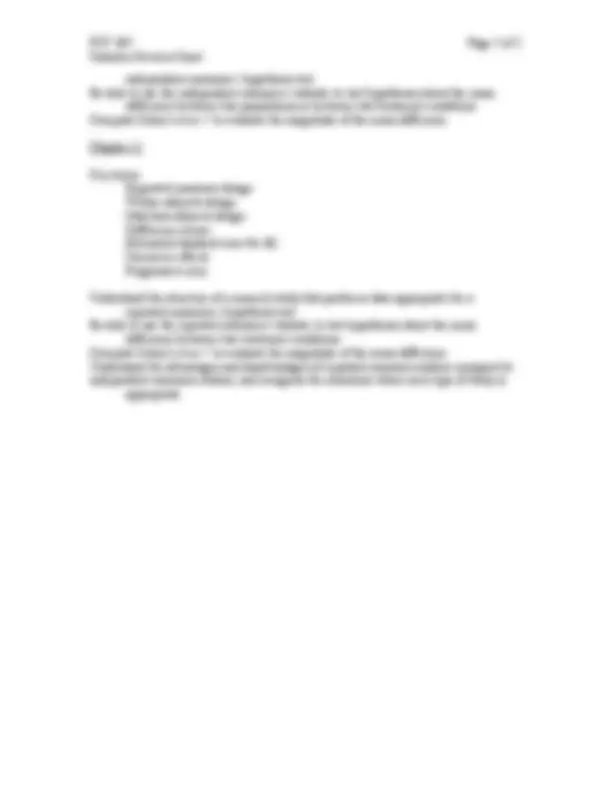



Study with the several resources on Docsity

Earn points by helping other students or get them with a premium plan


Prepare for your exams
Study with the several resources on Docsity

Earn points to download
Earn points by helping other students or get them with a premium plan
Community
Ask the community for help and clear up your study doubts
Discover the best universities in your country according to Docsity users
Free resources
Download our free guides on studying techniques, anxiety management strategies, and thesis advice from Docsity tutors
Material Type: Exam; Professor: Bui; Class: Statistics; Subject: Psychology; University: University of La Verne; Term: Unknown 1989;
Typology: Exams
1 / 2

This page cannot be seen from the preview
Don't miss anything!


PSY 305 Page 1 of 2 Statistics Review Sheet Review for Exam 3 (Chapters 8, 9, 10, 11) Chapter 8 Key terms Null hypothesis Alternative hypothesis Type I error Type II error Alpha level Critical region Level of significance Statistically significant Understand the logic of hypothesis testing Be able to state the hypotheses and locate the critical region Be able to conduct a hypothesis test using a z-score statistic and make a statistical decision Be able to define and differentiate between Type I and Type II errors Be able to compute Cohen’s d and understand the purpose of measuring effect size and Power Conduct a one-tailed (directional) test and state a directional hypothesis Chapter 9 Key terms Estimated standard error t statistic degrees of freedom percentage of variance accounted for ( r^2 ) Understand when a t statistic is used (instead of a z-score) for hypothesis testing) Perform a hypothesis test using the t statistic. Be able to compute sample means and variance and estimated error for sample mean Be able to compute Cohen’s d and percentage of variance accounted for to measure effect size Chapter 10 Key terms Independent-measures research design Between-subject research design Pooled variance Homogeneity of variance Understand the structure of a research study that produces data appropriate for an
PSY 305 Page 2 of 2 Statistics Review Sheet independent-measures t hypothesis test Be able to use the independent-measures t statistic to test hypotheses about the mean difference between two populations or between two treatment conditions. Compute Cohen’s d or r^2 to evaluate the magnitude of the mean difference Chapter 11 Key terms Repeated-measures design Within-subjects design Matched-subjects design Difference scores Estimated standard error for MD Carryover effects Progressive error Understand the structure of a research study that produces data appropriate for a repeated-measures t hypothesis test Be able to use the repeated measures t statistic to test hypotheses about the mean difference between two treatment conditions. Compute Cohen’s d or r^2 to evaluate the magnitude of the mean difference Understand the advantages and disadvantages of repeated-measures studies compared to independent-measures studies, and recognize the situations where each type of study is appropriate